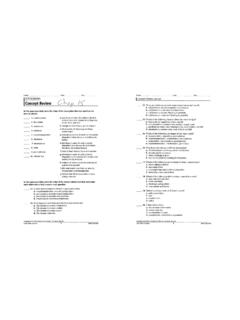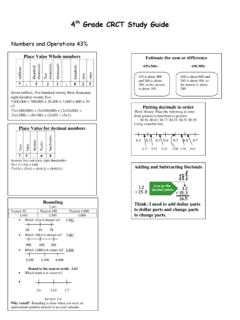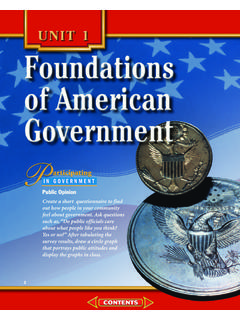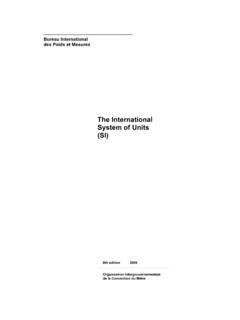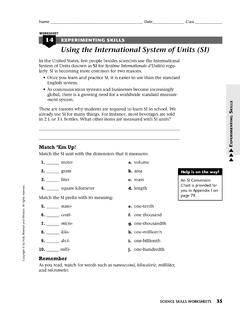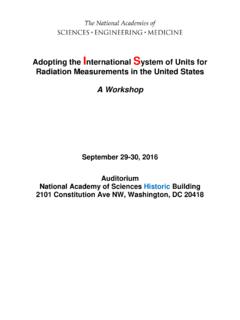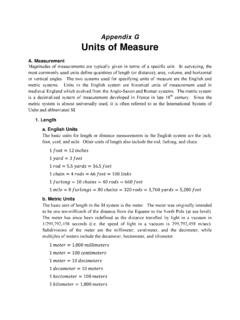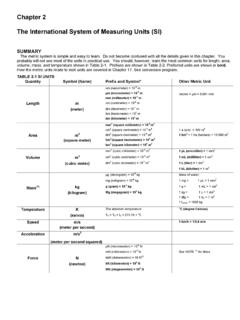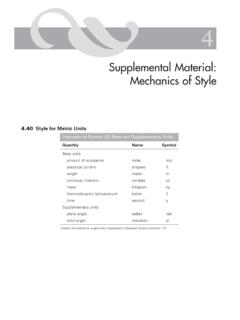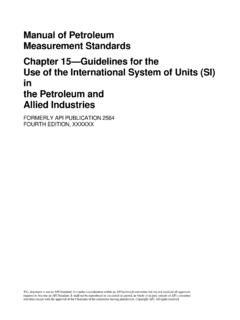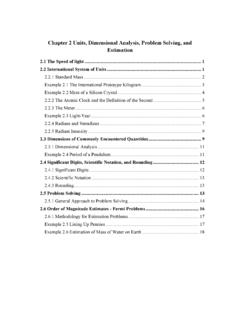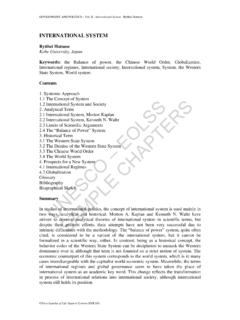Transcription of 3.2 The International System of Units 3
1 Scientific Measurement 73 Print Guided Reading and Study Workbook, Section Core Teaching Resources, Section Review, Interpreting Graphics Transparencies, T27 T30 Small-Scale Chemistry Lab Manual, Labs 3, 4, 5 Technology Interactive Textbook with ChemASAP, Problem-Solving , Assessment Go Online, Section FOCUS Objectives List SI Units of measurement and common SI prefixes. Distinguish between the mass and weight of an object. Convert between the Celsius and Kelvin temperature scales. Guide for Reading Build Vocabulary Word Parts Have students predict the meanings of the SI prefixes deci, centi, and milli from their knowledge of the words decimal, century, and millennium. Reading Strategy Preview Have students look at Tables , , , and Ask students to list any metric Units with which they are already familiar.
2 INSTRUCT Have students study the photograph and read the text that opens the sec-tion. Ask, Do any of the signs list a measurement? (No. The signs show only numbers. A measurement contains both a number and a unit .) How can you determine what Units are implied by the signs? (A library or Internet search will show that the names on the signs are towns in Australia, which adopted SI in 1970. The numbers on the signs represent distances in kilometers.)1L2L22 Section ResourcesConnecting to Your WorldSection The International System of Units73 Table Base UnitsMeasuring with SI UnitsAll measurements depend on Units that serve as reference standards. Thestandards of measurement used in science are those of the metric metric System is important because of its simplicity and ease of use.
3 Allmetric Units are based on multiples of 10. As a result, you can convertbetween Units easily. The metric System was originally established inFrance in 1795. The International System of Units (abbreviated SI, after theFrench name, Le Syst me International d unit s) is a revised version of themetric System . The SI was adopted by International agreement in are seven SI base Units , which are listed in Table From these baseunits, all other SI Units of measurement can be derived. The five SIbase Units commonly used by chemists are the meter, the kilogram, thekelvin, the second, and the measured quantities can be reported in SI Units . Sometimes, how-ever, non-SI Units are preferred for convenience or for practical reasons. Inthis textbook you will learn about both SI and non-SI International System of Units Are we there yet?
4 You may have asked this question during a long road trip with family or friends. To find out how much farther you have to go, you can read the roadside signs that list destinations and their distances. In the signs shown here, however, the distances are listed as numbers with no Units attached. Is Carrieton 44 kilometers or 44 miles away? Without the Units , you can t be sure. When you make a measurement, you must assign the correct Units to the numerical value. Without the Units , it is impossible to communicate the measurement clearly to others. Guide for ReadingKey Concepts Which five SI base Units do chemists commonly use? What metric Units are commonly used to measure length, volume, mass, temperature, and energy?VocabularyInternational System of Units (SI)meter (m)liter (L)kilogram (kg)gram (g)weighttemperatureCelsius scaleKelvin scaleabsolute zeroenergyjoule (J)calorie (cal)Reading StrategySummarizingAs you read about SI Units , summarize the main ideas in the text that follows the red and blue base unitSymbolLengthmetermMasskilogramkgTemp eraturekelvinKTimesecondsAmount of substancemolemolLuminous intensitycandelacdElectric currentampereA Page 73 Saturday, April 15, 2006 9.
5 04 AM 74 Chapter 3 Section (continued)74 Chapter 3 Length of 5 city blocks 1 kmTable Used Metric PrefixesPrefixMeaningFactormega (M) 1 million times larger than the unit it precedes106kilo (k)1000 times larger than the unit it precedes103deci (d)10 times smaller than the unit it precedes10 1centi (c)100 times smaller than the unit it precedes10 2milli (m)1000 times smaller than the unit it precedes10 3micro ( )1 million times smaller than the unit it precedes10 6nano (n)1000 million times smaller than the unit it precedes10 9pico (p)1 trillion times smaller than the unit it precedes10 12 Units and QuantitiesAs you already know, you don t measure length in kilograms or mass in cen-timeters. Different quantities require different Units . Before you make ameasurement, you must be familiar with the Units corresponding to thequantity that you are trying to of LengthSizeis an important property of matter.
6 In SI, the basicunit of length, or linear measure, is the meter (m). All measurements oflength can be expressed in meters. (The length of a page in this book isabout one-fourth of a meter.) For very large and very small lengths, how-ever, it may be more convenient to use a unit of length that has a lists the prefixes in common use. For example, the prefix milli-means 1/1000 (one-thousandth), so a millimeter (mm) is 1/1000 of a meter,or m. A hyphen (-) measures about 1 large distances, it is usually most appropriate to express measure-ments in kilometers (km). The prefix kilo-means 1000, so 1 km equals1000 m. A standard marathon distance race of about 42,000 m is more con-veniently expressed as 42 km (42 1000 m).
7 Common metric Units oflength include the centimeter, meter, and summa-rizes the relationships among metric Units of Units of LengthUnitRelationshipExampleKilometer (km)1 km 103 mlength of about five city blocks 1 kmMeter (m)base unitheight of doorknob from the floor 1 m Decimeter (dm)101 dm 1 mdiameter of large orange 1 dmCentimeter (cm)102 cm 1 mwidth of shirt button 1 cmMillimeter (mm)103 mm 1 mthickness of dime 1 mmMicrometer ( m)106 m 1 mdiameter of bacterial cell 1 mNanometer (nm)109 nm 1 mthickness of RNA molecule 1 nm Measuring with SI Units Discuss Explain that with the exception of those working in the sciences, the United States is the only country not using the metric System as a routine method of measurement.
8 Ask, What are some examples of applications in which the metric System is used in the United States. (Acceptable answers include 35-mm film; meter distances in track and field; the dimensions of tools (wrenches) and hardware (bolts); power rating in watts of appliances, and road signs.) Units and Quantities Use Visuals Table Discuss with students how SI prefixes are always in increments of ten and can be expressed using scien-tific notation. Ask, What does the pre-fix kilo mean? (The prefix kilo means 1000 times larger than the unit it pre-cedes.) How is this prefix represented in scientific notation? (10 3 ) How much larger is the prefix centi com-pared to the prefix micro? Show stu-dents how to make this comparison by writing the following on the board:centi/micro = 10 2 /10 6 = 10 2 ( 6) =10 ( 2 + 6) =10 4 Remind students that in dividing num-bers in scientific notation, the expo-nent of the denominator is subtracted from the exponent of the numerator.
9 Explain that the prefix centi is 10 4 , or 10, 000, times larger than the prefix micro .L2L1 Page 74 Wednesday, April 13, 2005 1:57 PM Scientific Measurement 75 DiscussDiscussPoint out that data can be reported accurately in various related Units (mm, cm, m), but it is best to choose the unit closest in scale to the object being measured. The unit of mass most often used by chemists is the gram not the kilo-gram. Kilograms of chemicals are too large for laboratory experiments. The density of most gases is mea-sured in grams per liter; the densities of most solids and liquids are mea-sured in grams per cubic centimeter. The milliliter is the most common unit of volume used by chemists. The cubic meter is much too large a vol-ume for most laboratory MeasurementsPurposeTo introduce students to laboratory equipment used to measure volumeMaterialssets of Erlenmeyer flasks, buret, graduated cylinder, beaker, and volumetric flask; water; food coloringSafetyHave students wear goggles to emphasize safety in the the demonstration, fill the glassware with water and add a few drops of food coloring.
10 Place the sets at various stations around the class-room. Assign groups of students to each station. As students inspect the glassware, explain that beakers, Erlenm-eyer flasks, and graduated cylinders are used to measure approximate volumes. Volumetric flasks and burets allow mea-surements that are more precise. Ask, What is the appropriate instrument to use to measure a large volume, such as a 1 L, accurately?(Students should choose the volumetric flask.)Expected OutcomeStudents should be able to select the appropriate glass-ware when presented with the volu-metric parameters for an 2000 cm3 Checkpointcubic meter (m3)SI Units of Distance and TimeIn 1790, with the establishment of the metric System , the French became the first to adopt measurement standards that were close to being precise.


